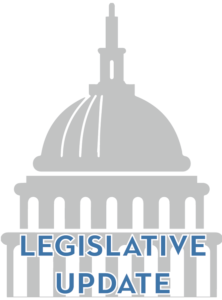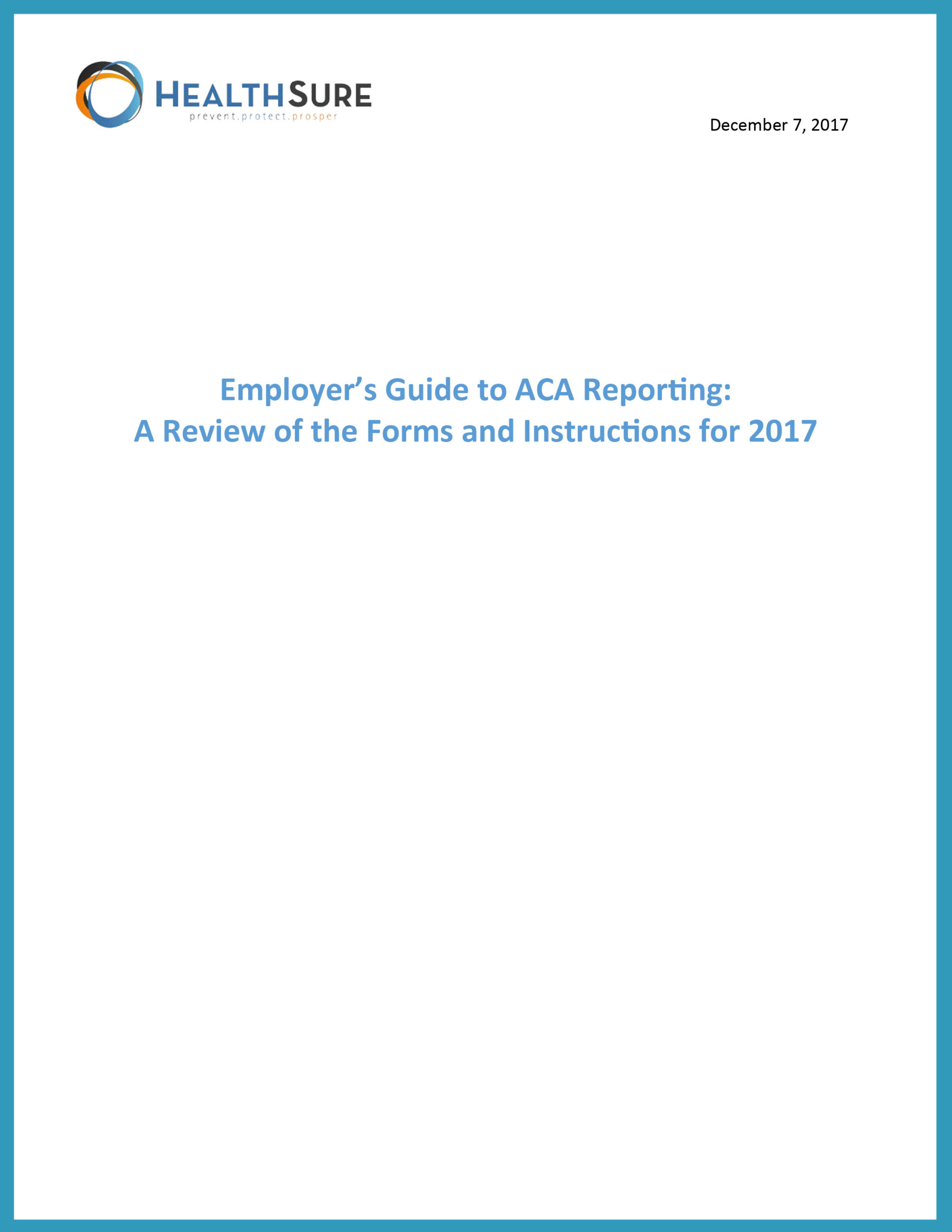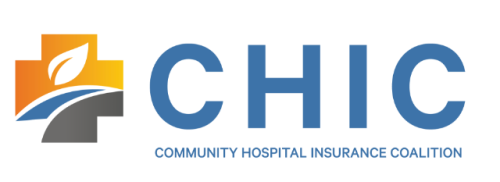Benefit Plan Limits for 2018 Announced
Preparing for ACA Reporting Season! Free Tool for HealthSure Client’s DIY1095 is available
Employer’s Guide to ACA Reporting: A Review of the Forms and Instructions for 2017
Over half of large employers have embraced telemedicine
Benefit Plan Limits for 2018 Announced
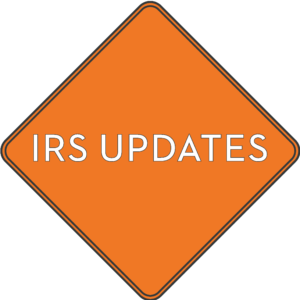
Many employee benefits are subject to annual dollar limits that are periodically increased for inflation. The IRS recently announced cost-of-living adjustments to the annual dollar limits for various welfare and retirement plan limits for 2018. Although some of the limits will remain the same, many of the limits will increase for 2018.
Employers should update their benefit plan designs for the new limits and also make sure that their plan administration will be consistent with the new limits in 2018. Employers may also want to communicate the new benefit plan limits to employees during annual open enrollment.
Health Savings Account 2018 Contribution Limits
- Self-only high deductible health plan (HDHP) coverage—$3,450
- Family HDHP coverage—$6,900
- Catch-up contributions*—$1,000
HDHP 2018 Limits
- Self-only coverage minimum deductible—$1,350
- Family coverage minimum deductible—$2,700
- Self-only coverage out-of-pocket maximum (OOPM)—$6,650
- Family coverage OOPM—$13,30
Flexible Spending Account (FSA) 2018 Contribution Limits
- Health FSA—$2,650
- Dependent care FSA*—$5,000 ($2,500 if married and filing taxes separately)
401(k) 2018 Contribution Limits
- Employee elective deferrals—$18,500
- Catch-up contributions—$6,000
*Not adjusted for inflation
Preparing for ACA Reporting Season! Free Tool for HealthSure Client’s DIY1095 is available
Believe it or not, the ACA Reporting Season will be here in the blink of an eye!
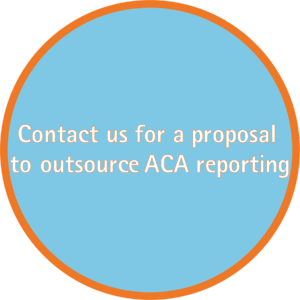
At this time, HealthSure clients can get free access to the updated portal and begin entering data needed to complete the 1094/1095 form. Whether you are new to DIY1095 or have used it previously, you will need to sign up again for 2017.
Accessing Data for Previous Years
Please note that none of the 2016 data was carried forward, meaning all clients will need to download the latest template from the site and copy/paste/input data as needed. Details on accessing data/forms from previous years can be found in the Administrative Users Guide, which can be downloaded from the DIY 1095 Dashboard.
Who is responsible for sending 1094/1095?
Insurance Carriers send out form 1094-B and 1095-B for fully-insured plans.
Small Employers (employers with fewer than 50 full-time equivalent employees on average in prior calendar year) sponsoring self-insured plans must report using 1094-B and 1095-B (Parts I and III).
Applicable Large Group Employers (employers with 50 or more full-time equivalent employees on average in prior calendar year) must report using forms 1094-C and 1095-C (Parts 1 and II only) if fully-insured. If the group sponsors a self-insured plan, they are responsible for generating and sending Form 1094-C and 1095-C – Parts I, II, and III.
Signing up
Everyone will need to sign up for DIY1095 for 2017 regardless of whether or not they used DIY1095 for last year’s filing. If you wish to sign up, please send the following information to your Account Manager:
Employer name
FEIN #
HR Administrator’s first and last name
HR Administrator’s email address
Broker’s name
Estimated # of employees
Once you have emailed the information above, you will receive an email that will provide a link, username, and a temporary password that will allow you access to the portal.
Deadlines for filing the 1094/1095 forms:
- January 31, 2018 – deadline to mail 1095s to employees
- February 28, 2018 – deadline to submit paper forms to the IRS (those filing less than 250 forms)
- March 31, 2018 – deadline to e-File to the IRS
For clients who need to e-file – Any clients with over 250 employees are required to e-file. For clients who need or want to e-file, DIY1095 has partnered with Nelco once again. Please note that if Nelco is used to e –file, there will be a charge. If you need prices or more information regarding e-filing, please email your HealthSure Account Manager.
IRS Updates Employer Mandate FAQs, Indicates that Penalty Letters are Imminent; Issues Form Letter 226J
by Marathas Barrow Weatherhead Lent LLP, a national law firm with recognized experts on the Affordable Care Act.

The Internal Revenue Service (IRS) has updated its list of frequently asked questions (FAQs) on the Affordable Care Act’s employer shared responsibility provisions – also known as the “pay or play” mandate. In particular, questions 55 through 58 provide guidance for employers who may be subject to shared responsibility payments. The FAQs indicate that the IRS will begin sending penalty letters to applicable large employers (ALEs) that owe penalties for calendar year 2015 “in late 2017.” Around this time last year, the IRS had indicated that penalty letters for 2015 would be coming “in early 2017;” however, those letters never materialized. Based on the latest update to its FAQs, it appears that the IRS has worked out the kinks in its systems and is prepared to begin sending penalty letters.
The general procedures the IRS will use to propose and assess the employer shared responsibility payment are described in Letter 226J, which is the initial proposal of the penalty that may be owed. The IRS recently published Understanding your Letter 226J for ALEs to understand what they need to do and what they may want to do if they receive Letter 226J.
Background
Starting in 2015, the ACA requires ALEs to either “play” by offering affordable health coverage to their full-time employees, or “pay” a penalty if the employer fails to provide affordable health coverage and at least one full-time employee receives a premium tax credit to help purchase coverage through the Health Insurance Marketplace. ALEs are generally those with 50 or more full-time employees, including full-time equivalent employees. Transitional relief was available for 2015 (and, for non-calendar year plans, any portion of the 2015 plan year that fell in 2016) for ALEs with fewer than 100 full-time employees that satisfied the conditions of such transitional relief.
In general, there are two potential penalties (both non-deductible for tax purposes) that could be imposed on an ALE for failure to satisfy the mandate. The first penalty, known as the “no coverage” penalty, is based on whether an ALE fails to offer group health plan coverage to at least 95% (70% during 2015 plus, for non-calendar year plans, any calendar months of 2016 that fell within the 2015 plan year) of its full-time employees. In this case, the annual penalty is $2,000 per full-time employee minus 30 (minus 80 for 2015, plus any calendar months of 2016 that fell within the 2015 plan year) full-time employees if at least one employee receives a premium tax credit for Marketplace coverage. The second penalty, known as the “unaffordability” penalty, applies when an employer offers coverage that fails to meet certain affordability and minimum value requirements. In that case, the annual penalty is $3,000 for each full-time employee who receives a premium tax credit for Marketplace coverage, but no more than what the “no coverage” penalty would be if it applied. As noted above, several types of transition relief applied for 2015 (for non-calendar-year plans, some aspects of the relief continued for months of the 2015 plan year that fell in the 2016 calendar year). This transition relief delayed application of the penalties for certain ALE members and reduced the penalty amount for others. This transition relief has now expired.
The annual penalties are prorated on a monthly basis and are indexed each year for inflation, as shown in the following table:
| Penalty Type | “No Coverage” | “Unaffordablity” |
| Description | Coverage not offered to 95%** of full-time employees | Coverage offered, but unaffordable or is not minimum value |
| 2018 | $2,320 | $3,480 |
| 2017 | $2,260 | $3,390 |
| 2016 | $2,160 | $3,240 |
| 2015 | $2,080 | $3,120 |
| 2014* | $2,000 | $3,000 |
*No employer shared responsibility penalties will be assessed for 2014.
** 70% during 2015 (plus, for non-calendar year plans, any calendar months of 2016 that fell within the 2015 plan year)
The IRS’ Penalty Process
The FAQs indicate that the IRS will use Letter 226-J to propose and assess penalties. Letter 226J will be issued if the IRS determines that, for at least one month in the year, at least one of the ALE’s full-time employees was enrolled in subsidized coverage through the Marketplace and the ALE did not qualify for an affordability safe harbor (or other relief for the employee). The determination of whether an ALE may be liable for a penalty and the amount of the proposed penalty in Letter 226J are based on information from Forms 1094-C and 1095-C filed by the ALE and the individual income tax returns filed by the ALE’s employees. The letter will include, among other things, the following:
- a brief explanation of the pay-or-play provisions;
- a table itemizing the proposed penalty by month and whether the liability is under the “no coverage” provision, the “unaffordability” provision or neither;
an employer shared responsibility response form (Form 14764 – ESRP Response); - a list of full-time employees who received subsidized Marketplace coverage each month (Form 14765 – Employee Premium Tax Credit List) and for whom the ALE did not qualify for an
affordability safe harbor or other relief; - a description of the actions the ALE should take if it agrees or disagrees with the proposed payment amount in Letter 226J; and
- a description of the actions the IRS will take if the ALE does not respond timely.
The response to Letter 226J will be due by the response date shown on that letter, which generally will be 30 days from the date of Letter 226J. The letter will contain the name and contact information of a specific IRS employee that the ALE should contact if it has questions about the letter.
A copy of Letter 226J can be found here: https://www.irs.gov/pub/notices/ltr226j.pdf.
Employer Response
ALEs will have an opportunity to contest any proposed penalty notices. ALEs that receive a Letter 226J may respond to the IRS about the proposed payment, including requesting a pre-assessment conference with the IRS Office of Appeals. The letter will provide instructions for how the ALE should respond in writing, either agreeing with the proposed penalty amount or disagreeing with all or a portion of it. ALEs may allow someone to contact the IRS on their behalf so long as they send the IRS a Form 2848 (Power of Attorney and Declaration of Representative) that states specifically the year and that it is for the Section 4980H Shared Responsibility Payment.
If an ALE agrees with the penalty determination, it must complete and return a Form 14764, ESRP Response, that is enclosed with the letter, and include full payment by check or money order for the penalty amount assessed (or, if enrolled in the Electronic Federal Tax Payment System (EFTPS), pay electronically).
If an ALE disagrees with the penalty determination, the enclosed Form 14764, ESRP Response, will also include a Form 14764 to send to the IRS and it will need to include a signed statement explaining the basis for the disagreement. The ALE may include any documentation (e.g., offer of coverage records) with the supporting statement. The statement must also include what changes the ALE would like to make to the Forms 1094-C and/or 1095-C on the enclosed “Employee PTC Listing.” However, the instructions state that an ALE should not file a corrected Form 1094-C or 1095-C. The Letter 226J includes additional, specific instructions on making changes to the Employee PTC Listing.
If the ALE responds to Letter 226J, the IRS will acknowledge the ALE’s response with one of five versions of Letter 227 (which, in general, acknowledge the ALE’s response and describe further actions the ALE may need to take). If, after receipt of Letter 227, the ALE disagrees with the proposed or revised employer shared responsibility payment amount, it may request a pre-assessment conference with the IRS Office of Appeals. The ALE should follow the instructions provided in Letter 227 and Publication 5 for requesting a conference with the IRS Office of Appeals. A conference should be requested in writing by the response date shown on Letter 227, which generally will be 30 days from the date of Letter 227.
If the ALE does not respond to either Letter 226J or Letter 227, the IRS will assess the amount of the proposed penalty and issue a notice and demand for payment (Notice CP 220J). Notice CP 220J will include a summary of the ALE’s payment responsibility and will reflect payments made, credits applied, and the balance due, if any. The notice will instruct the ALE how to make payment, if any. ALEs will not be required to include the employer shared responsibility payment on any tax return that they file or to make payment before notice and demand for payment. ALEs may have the ability to make installment payments, as described in Publication 594.
Next Steps
There were numerous legislative efforts by the Trump administration earlier this year to repeal and replace the ACA, including retroactively eliminating the individual and employer shared responsibility mandates. Recently, there have been discussions that Republicans may again try to repeal those mandates as part of their tax reform bill. However, to date, no such repeal bills have passed, and the most recent proposed tax reform bill does not include a repeal of the mandates. In the absence of a repeal, employers should be prepared to respond to any IRS penalty letters and continue to prepare for 2017 reporting (in 2018).
The IRS will be determining penalty responsibility based on an employer’s ACA reporting (Forms 1094-C and 1095-C), along with information regarding an individual’s receipt of a premium tax credit. ALEs who have been offering affordable, minimum value coverage to full-time employees should ensure that they have all information necessary to appeal any proposed penalty assessments, including payroll records and documentation regarding how offers of coverage are made. While the IRS FAQs indicate that the IRS plans to issue Letter 226J for the 2015 calendar year (which generally applied to ALEs with 100 or more full-time employees), it is a good time for ALEs in later years to start reviewing and gathering information that they may need to respond to Letter 226J as well.
Employers that receive Letter 226J should review it carefully and consider whether there is a basis to pursue an appeal, including whether the employee was full-time for ACA purposes in each month for which a penalty is assessed. For example, employers may need to demonstrate to the IRS that they were using permissible measurement and stability periods and that the employee in question qualified as a “variable hour employee,” if the employer is claiming that an employee who worked 130 hours in a particular month was not full-time for ACA purposes. Employers who receive Letter 226J should be mindful of the response deadline, which will generally be 30 days from the issuance date appearing on the letter, and should consider taking steps now (such as working with human resources, legal, benefits, payroll, and finance departments as well as outside vendors housing your ACA data) to set up a process to ensure timely review and response to any Letter 226J. Depending on mailing delays and internal routing, an employer may have a very short timeframe before the due date to respond, so advanced planning is critical. In anticipation of receipt of any Letter 226J and in light of the relatively short time frame in which to respond, employers may want to consider securing a Form 2848 (Power of Attorney and Declaration of Representative) now to allow someone, such as employee benefits counsel, to contact the IRS on their behalf.
Employers that receive subsidy notification letters from the Marketplace during the year should consider appealing them when there is a basis to do so. In many cases, employers receive Marketplace subsidy letters for individuals who are not full-time for ACA purposes, and thus there is no basis for an appeal. In other words, an employer would not appeal a premium subsidy notice for a part-time employee to whom the employer did not offer coverage (that person would be a prime candidate for subsidized coverage).
Employers should also be reminded that the ACA Section 1558 prohibits retaliation against employees who receive premium tax credits. Among other things, employers are prohibited from discharging or discriminating against an employee because the employee received a premium tax credit. Employers violating Section 1558 may be required to reinstate the employee to his or her former position (and provide back pay) and may be subject to compensatory damages, costs and expenses (including attorneys’ fees) incurred by the employee in connection with the bringing of a complaint.
Employers that have questions regarding Letter 226J or IRS response letters should consult with qualified benefits counsel so that the relevant facts and circumstances can be reviewed.
- The Senate voted 51-49 recently to advance their tax reform plan. It is now being conferenced between House and Senate members, with the goal of passing a final version this week.
- Representatives Billy Long (R-MO) and Kurt Schrader (D-OR) introduced H.R. 4575, a bill to exclude broker commissions from the medical loss ratio. A Senate companion is forthcoming.
- HHS Secretary Nominee Alex Azar is expected to face a confirmation hearing in the Senate Finance Committee the week of December 18. If advanced, he will need at least 50 votes to be confirmed by the full Senate.
- The House voted 235-193 and the Senate voted 81-14 to approve a two-week continuing resolution through December 22 that also included a limited short-term patch for the Children’s Health Insurance Program.
- Negotiations are continuing over a longer-term funding bill that may include market stability measures, including temporary funding of the ACA’s Cost-sharing reduction program.
Employer’s Guide to ACA Reporting: A Review of the Forms and Instructions for 2017
There were numerous legislative efforts by the Trump administration in 2017 to repeal and replace the Affordable Care Act, including retroactively eliminating the individual and employer shared responsibility mandates. In early December, there have been discussions that Republicans may again try to repeal those mandates as part of their tax reform bill. However, to date, no such repeal bills have passed, and although the most recent proposed tax reform bill from the Senate includes a repeal of the individual mandate beginning in 2019, it does not include a repeal of the employer mandate. In the absence of a repeal, employers should be prepared to respond to any IRS penalty letters and continue to prepare for 2017 reporting (in 2018).
The IRS has released the final versions of its employer and provider reporting forms and instructions for 2017. Links to the forms and instructions are below:
Form 1094-C: www.irs.gov/pub/irs-pdf/f1094c.pdf
Form 1095-C: www.irs.gov/pub/irs-pdf/f1095c.pdf
Form 1094-C / 1095-C Instructions: www.irs.gov/pub/irs-pdf/i109495c.pdf
Form 1094-B: www.irs.gov/pub/irs-pdf/f1094b.pdf
Form 1095-B: www.irs.gov/pub/irs-pdf/f1095b.pdf
Form 1094-B / 1095-B Instructions: www.irs.gov/pub/irs-pdf/i109495b.pdf
Additional IRS guidance can be found here:
Q/A’s on Reporting by Health Coverage Providers (Section 6055): www.irs.gov/affordable-care-act/questions-and-answers-on-information-reporting-by-health-coverage-providers-section-6055
Q/A’s on Reporting of Offers of Health Coverage by Employers (Section 6056): www.irs.gov/affordable-care-act/employers/questions-and-answers-on-reporting-of-offers-of-health-insurance-coverage-by-employers-section-6056
Q/A’s about Information Reporting by Employers on Form 1094-C and Form 1095-C: www.irs.gov/affordable-care-act/employers/questions-and-answers-about-information-reporting-by-employers-on-form-1094-c-and-form-1095-c
Q/A’s on Employer Shared Responsibility Provisions Under the ACA: www.irs.gov/affordable-care-act/employers/questions-and-answers-on-employer-shared-responsibility-provisions-under-the-affordable-care-act
This guide reviews the 2017 forms and instructions and notes relevant changes from 2016. It also addresses IRS guidance on the solicitation of social security numbers (“SSNs”) or taxpayer identification numbers (“TINs”) and the treatment of cash “opt-out” payments for reporting purposes. It also provides guidance for employers that receive Letter 226J, notice of a proposed shared responsibility payment.
The reporting requirements are complex, due in part to how the health care reform law was drafted. The Affordable Care Act added two new sections to the Internal Revenue Code: Sections 6055 and 6056. The sections are found next to each other in the Code; however, they apply to different types of entities. Section 6055 applies to providers of health insurance, such as health insurance carriers and employers that sponsor self-insured plans. Section 6056 applies to “applicable large employers” or “ALEs”, which are employers with 50 or more full-time equivalent employees in the prior calendar year.
To further complicate things, the reporting forms come in two different “series” – the B-Series and the C-Series forms. Employers may use either or both sets depending on their company size and whether their group health plan is self-insured or fully insured. Our goal with this guide is to provide some clarity and best practices for employers.
According to the annual Kaiser Family Foundation and the Health Research & Educational Trust employer health benefits survey, over half of large employers have embraced telemedicine, with 63 percent offering health care services through this method.
Of these employers, 33 percent offer financial incentives to receive health care services this way, as opposed to an in-person physician visit.
For more information on telemedicine, or to see the survey in full, contact HealthSure today.


